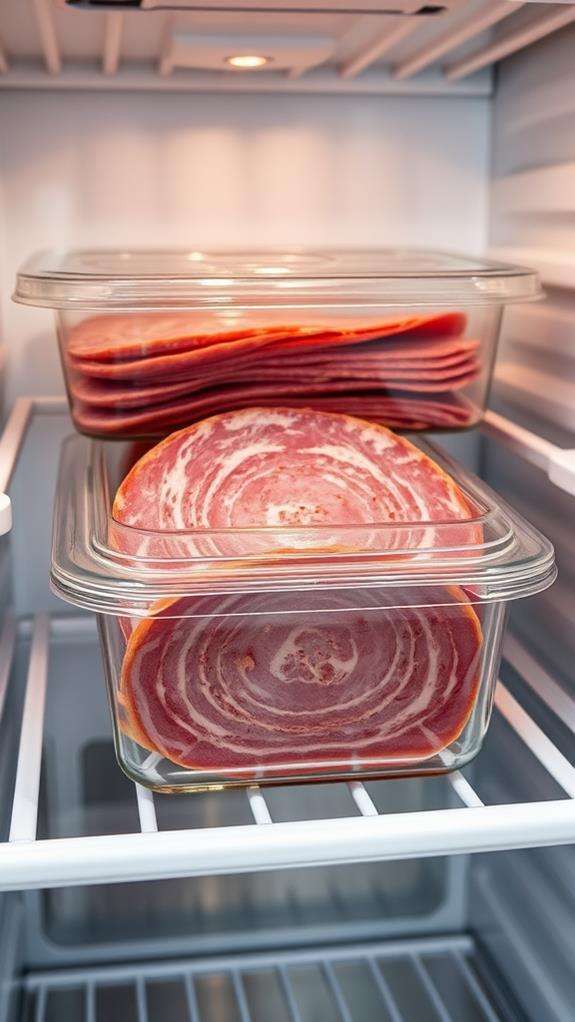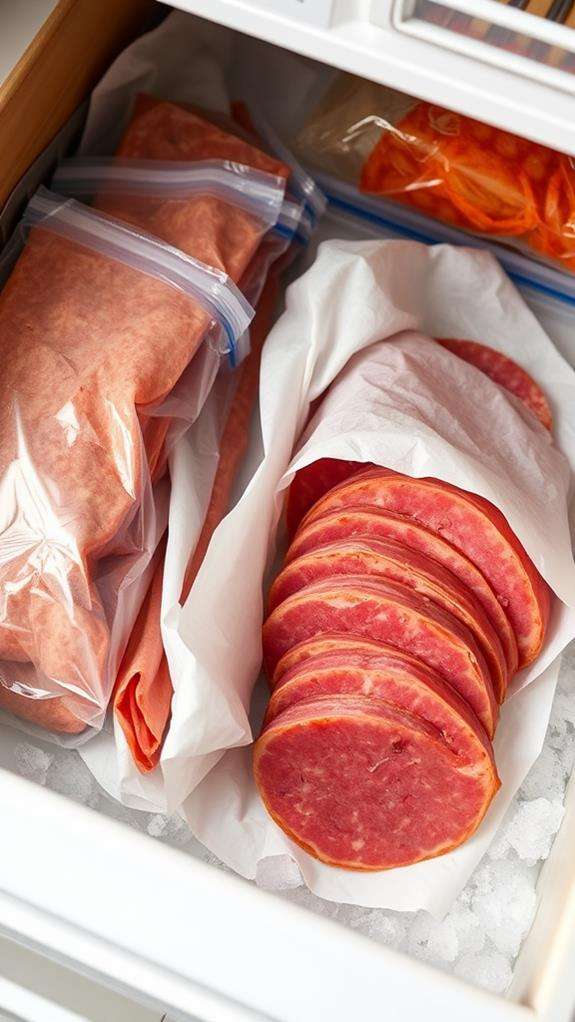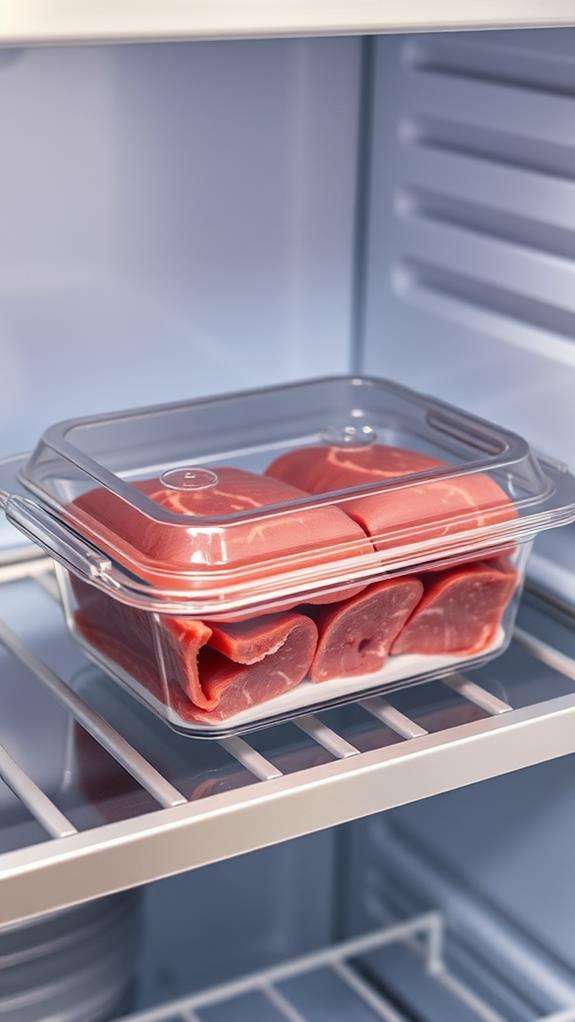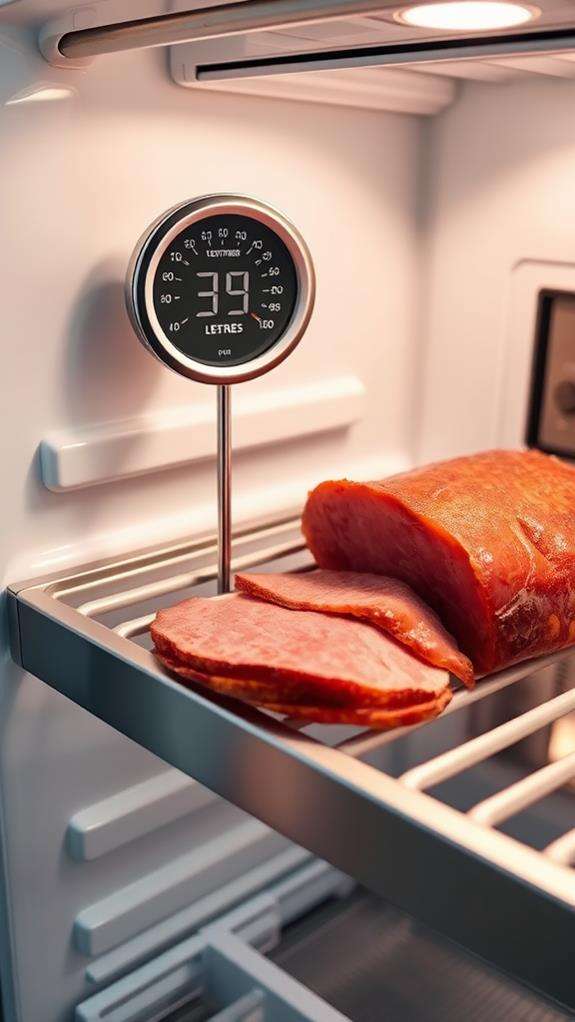How Long Does Pastrami Last in the Fridge
Your properly stored pastrami will last 5-7 days in the refrigerator when kept at or below 40°F (4°C). If you've got an unopened, vacuum-sealed package, it can stay fresh for up to 21 days at the same temperature. You'll need to store your pastrami in an airtight container or wrap it tightly in plastic wrap, aluminum foil, or butcher paper to maintain freshness. Watch for signs of spoilage like discoloration, unusual odors, or slimy texture. When freezing pastrami, you can extend its life to 2-3 months. For ideal safety and quality, there's much more to take into account about proper storage techniques and temperature control.
This post may contain affiliate links. If you make a purchase through these links, I may earn a commission at no additional cost to you. Additionally, portions of this post may be generated using artificial intelligence (AI) technology. While we strive for accuracy, please be aware that AI-generated content may not always be perfect and should be fact-checked when necessary.
The Spatula Scoops
- Fresh pastrami lasts 5-7 days in the refrigerator when properly stored at 40°F (4°C) or below.
- Unopened vacuum-sealed pastrami can last up to 21 days when maintained at proper refrigeration temperatures.
- Using airtight containers can extend freshness by an additional week beyond standard storage time.
- Double-wrapping with butcher paper adds 4-5 days, aluminum foil 3-4 days, and plastic wrap 2-3 days.
- Pastrami should be discarded if left above 45°F (7°C) for more than 2 hours, regardless of initial storage time.
Understanding Pastrami Storage Basics

When it comes to storing pastrami properly, understanding the basics can make a significant difference in its shelf life and quality. You'll need to take into account several key factors, including temperature control, packaging methods, and storage conditions to maintain your pastrami's taste and safety.
Your refrigerator should maintain a consistent temperature between 34-40°F (1-4°C), as this range helps prevent bacterial growth while preserving the meat's moisture content. You'll want to keep your pastrami in an airtight container or wrapped tightly in plastic wrap, followed by a layer of aluminum foil to prevent oxidation and protect against freezer burn if you're planning longer storage.
If you've purchased pre-packaged pastrami, you should check the manufacturing date and "best by" information printed on the package. Once you've opened the original packaging, you'll need to transfer any unused portions to an appropriate storage container. Don't leave the pastrami sitting at room temperature for more than two hours, as this can promote bacterial growth and compromise food safety. Additionally, you should place the pastrami in the coldest part of your refrigerator, typically toward the back.
Refrigeration Time For Fresh Pastrami

When storing fresh pastrami in your fridge, you'll want to follow specific temperature and packaging guidelines to maintain its quality for 5-7 days at 40°F (4°C) or below. You can extend your pastrami's shelf life by wrapping it tightly in plastic wrap or aluminum foil, then placing it in an airtight container to prevent moisture loss and protect against refrigerator odors. To avoid quality deterioration, always check for any signs of spoilage before eating, including changes in color, texture, or smell, and confirm you're dating the package when you first store it.
Storage Guidelines for Fresh
Fresh pastrami should be stored in the refrigerator immediately after purchase or preparation and will last 3-5 days when properly wrapped. To maximize freshness, you'll want to wrap your pastrami tightly in butcher paper or aluminum foil, then place it in an airtight container or heavy-duty plastic bag to prevent moisture loss and protect against absorbing other food odors.
For ideal storage conditions, keep your pastrami in the coldest part of your refrigerator, typically at the back, where the temperature remains consistently between 34-38°F (1-3°C). Don't store it in the door compartments, as these areas experience temperature fluctuations each time you open the fridge. If you've sliced your pastrami, layer the pieces with wax paper between them to prevent sticking and make it easier to separate portions later.
You'll know your pastrami is still fresh if it maintains its deep red color and doesn't develop any slimy texture or off-putting odors. If you notice any discoloration, particularly gray or brown spots, or detect an unusual smell, it's best to discard the meat rather than risk foodborne illness.
Avoid Quality Loss Tips
To maintain your pastrami's peak quality during its 3-5 day refrigeration window, you'll need to take several preventive steps. Store your pastrami in an airtight container or wrap it tightly in plastic wrap, followed by aluminum foil, to create a protective double barrier against air exposure.
| Storage Factor | What to Do | What to Avoid | Impact |
|---|---|---|---|
| Temperature | Keep at 40°F or below | Temperature fluctuations | Prevents bacterial growth |
| Moisture | Use paper towels to absorb excess | Direct contact with liquids | Reduces spoilage risk |
| Air Exposure | Double-wrap tightly | Loose wrapping | Prevents oxidation |
| Container Type | Use airtight containers | Open containers | Maintains freshness |
You'll want to place your wrapped pastrami in the meat drawer of your refrigerator, where temperatures remain most consistent. Don't stack other items on top of your pastrami, as this can create pressure points that compromise the meat's texture. When you're ready to use it, only remove the portion you'll eat immediately, keeping the rest properly wrapped. If you notice any moisture accumulation inside the packaging, rewrap the meat with fresh materials to prevent premature spoilage.
Signs of Spoiled Pastrami

Safety demands that you know how to identify spoiled pastrami before consuming it. Your senses are your best tools for detecting whether your pastrami has gone bad, and you'll want to check multiple indicators before making a judgment.
First, examine the color of your pastrami. If you notice any grey, green, or blue spots, especially those with a fuzzy texture indicating mold growth, it's time to discard the meat. The meat's surface shouldn't have any slimy film or unusual discoloration. Next, trust your nose – fresh pastrami has a distinct, spiced aroma, but if you detect any sour, rancid, or unusually strong smells, don't risk eating it. The texture should be firm but not hard; if it's excessively dry, sticky, or slimy to touch, that's another red flag. Finally, if you see any liquid pooling in the package that appears cloudy or has an off-putting odor, your pastrami has likely spoiled. You shouldn't taste the meat to test its safety – if you've noticed any of these warning signs, it's best to err on the side of caution and dispose of it properly.
Proper Storage Methods

To keep your pastrami fresh, you'll want to store it in an airtight container or wrap it tightly in plastic wrap, making sure there's minimal air contact with the meat's surface. The ideal refrigerator temperature for storing pastrami is between 34-40°F (1-4°C), and you should place it in the coldest part of your fridge, typically near the back. For extra protection against moisture and unwanted odors, you can double-wrap your pastrami by first using butcher paper or plastic wrap, then placing it in a sealed container or resealable plastic bag.
Airtight Container Guidelines
Proper storage begins with selecting an airtight container that's specifically designed for deli meats. You'll want to choose a container with a tight-fitting lid and a rubber or silicone seal to prevent air from entering and moisture from escaping. Glass or BPA-free plastic containers work best, as they won't absorb odors or stains from the pastrami.
When selecting your container size, opt for one that closely matches the amount of pastrami you're storing. Too much empty space can lead to oxidation, while an overcrowded container won't seal properly. You'll need to guarantee the container's walls are thick enough to provide insulation and prevent temperature fluctuations that could compromise your pastrami's quality.
Before placing your pastrami in the container, wrap it in wax paper or food-grade butcher paper to create an additional barrier against moisture. Don't use regular plastic wrap, as it can trap excess moisture and accelerate spoilage. Make sure to check that the container's seal is clean and free from food particles before closing, and press down firmly on all sides to create an airtight environment that'll keep your pastrami fresh longer.
Temperature Control Tips
Maintaining the right temperature stands at the forefront of pastrami preservation, even with the best container. You'll need to verify your refrigerator maintains a consistent temperature between 32-40°F (0-4°C), with 36°F (2°C) being preferable for deli meats. Always use a reliable refrigerator thermometer to monitor these conditions.
| Temperature Zone | Safety Level | Duration | Best Practices |
|---|---|---|---|
| Below 32°F | Too Cold | N/A | May freeze and affect texture |
| 32-40°F | Ideal | 5-7 days | Perfect storage range |
| 41-45°F | Risk Zone | 2-3 days | Monitor closely |
| Above 45°F | Danger Zone | 2 hours max | Dispose if exceeded |
Don't store your pastrami in the refrigerator door, as temperatures fluctuate there each time you open it. Instead, place it in the main compartment's back section, where temperatures remain most stable. If you notice any temperature spikes above 40°F lasting longer than two hours, you'll need to evaluate your pastrami's safety. Remember to return the meat to the fridge promptly after each use, as extended periods at room temperature accelerate bacterial growth.
Freezing Pastrami Guidelines

While storing pastrami in the fridge works for short periods, freezing offers a much longer shelf life of up to 2-3 months. To properly freeze your pastrami, you'll need to wrap it tightly in freezer paper or heavy-duty aluminum foil, then place it in a freezer-safe plastic bag to prevent freezer burn.
Before wrapping your pastrami, slice it into portions you'll likely use in one sitting, as you shouldn't refreeze thawed meat. Make sure to squeeze out as much air as possible from the packaging, and label each package with the date you're freezing it. You can use a vacuum sealer for best results, which will help maintain the meat's quality and prevent ice crystal formation.
When you're ready to use your frozen pastrami, transfer it to your refrigerator and allow it to thaw gradually for 24-48 hours. Don't thaw it at room temperature, as this can promote bacterial growth. Once thawed, you'll need to consume the pastrami within 3-5 days. If you notice any freezer burn, unusual odors, or discoloration after thawing, it's best to discard the meat.
Unopened Versus Opened Shelf Life

The shelf life of pastrami varies considerably between unopened and opened packages. When you've got an unopened, vacuum-sealed package of pastrami from the store, you can typically keep it refrigerated for up to 21 days, provided you maintain a consistent temperature of 40°F (4°C) or below. You'll want to check the "best by" date on the package, as this serves as your primary guideline for unopened storage.
Once you've opened your pastrami, the storage timeline changes appreciably. An opened package will last 5-7 days in your refrigerator when properly stored in an airtight container or wrapped tightly in plastic wrap or aluminum foil. You'll notice that the meat's quality starts declining after the fifth day, even with proper storage. If you've purchased fresh-sliced pastrami from a deli counter, treat it as opened pastrami and follow the 5-7 day guideline. The key factors affecting shelf life include your refrigerator's temperature consistency, the packaging's integrity, and how frequently you're opening the container. Remember to always check for any signs of spoilage before consumption, regardless of these timeframes.
Extending Pastrami Freshness

Smart food storage techniques can greatly extend your pastrami's freshness beyond basic refrigeration. You'll want to implement several proven methods to maintain quality and prevent premature spoilage. The key lies in proper wrapping, temperature control, and moisture management.
| Storage Method | Expected Freshness Extension |
|---|---|
| Vacuum Sealing | 2-3 weeks additional |
| Butcher Paper | 4-5 days additional |
| Aluminum Foil | 3-4 days additional |
| Plastic Wrap | 2-3 days additional |
| Airtight Container | 1 week additional |
To maximize your pastrami's shelf life, you'll need to wrap it tightly in butcher paper or plastic wrap, then place it in an airtight container. Store it in the coldest part of your fridge, typically the back, where temperatures remain most consistent. Don't forget to monitor humidity levels – excess moisture leads to bacterial growth, while too little causes drying. If you're planning long-term storage, consider portioning your pastrami before wrapping it. This approach lets you thaw only what you'll use, reducing exposure to temperature fluctuations and contamination risks.
Safe Handling Practices

Practicing safe handling measures keeps your pastrami fresh and prevents foodborne illness. When you're handling pastrami, always start with clean hands, washing them thoroughly with soap and warm water for at least 20 seconds. Use separate cutting boards and utensils for your deli meats to avoid cross-contamination with other foods, especially raw meat and produce.
You'll want to store your pastrami in an airtight container or sealed plastic bag, removing as much air as possible before sealing. Don't leave the meat at room temperature for more than two hours, and if you're serving it at a gathering, keep it on ice or in a chilled container. When you're portioning pastrami, use clean utensils each time, and avoid touching the meat directly with your hands.
Make sure your refrigerator maintains a consistent temperature between 34-40°F (1-4°C). Store the pastrami in the meat drawer or on a bottom shelf to prevent any drips from contaminating other foods. If you notice any unusual odors, discoloration, or slimy texture, it's best to discard the pastrami immediately, even if it hasn't reached its expiration date.
Food Safety Temperature Requirements

Maintaining proper temperature control is critical for pastrami safety throughout storage and serving. You'll need to keep your refrigerator at or below 40°F (4°C) to prevent bacterial growth, and it's crucial to monitor these temperatures regularly with a reliable thermometer. It's also important to note that internal temperatures of cooked meats, like turkey, must reach at least 165°F (74°C) to guarantee food safety, and minimum safe temperatures can vary based on the type of meat.
When you're handling pastrami, be aware of the "danger zone" – temperatures between 40°F and 140°F (4°C to 60°C) where bacteria multiply rapidly. Don't leave your pastrami out at room temperature for more than two hours, or one hour if the ambient temperature exceeds 90°F (32°C). If you're reheating pastrami, verify it reaches an internal temperature of 165°F (74°C) to kill any potential harmful bacteria.
Your refrigerator's temperature can fluctuate based on factors like door openings and the amount of food stored. Place your pastrami in the coldest part of your fridge, typically the back of the bottom shelf, where temperatures remain most consistent. If you're storing multiple packages, don't stack them tightly together, as this can create warm spots where bacteria might thrive. Regular temperature checks using a refrigerator thermometer will help guarantee your pastrami stays safe to eat.
Frequently Asked Questions
Can I Eat Pastrami Straight From the Package Without Heating It?
Like a ready-to-go smartphone, most packaged pastrami comes fully cooked and safe to eat straight from the package. You'll find two main types: refrigerated and vacuum-sealed. While you can eat both cold, warming your pastrami enhances its flavors and texture, making it more enjoyable. If you're using refrigerated deli-sliced pastrami, you'll want to consume it within 3-5 days after opening for the best quality and food safety.
Does Pastrami Need to Rest After Heating Before Making Sandwiches?
You don't need to let pastrami rest after heating like you would with larger cuts of meat. Since pastrami is typically sliced thin and already fully cooked, you can use it immediately for your sandwiches. However, if you're heating a whole piece of pastrami, letting it rest for 5-10 minutes helps retain its juices and makes it easier to slice. For pre-sliced pastrami, you can start building your sandwich right away.
Why Does Store-Bought Pastrami Taste Different From Deli Pastrami?
Store-bought pastrami often tastes different from deli pastrami because of processing methods and quality control. You'll find that deli pastrami is typically fresher, hand-sliced, and made in smaller batches with traditional smoking and curing techniques. In contrast, store-bought versions usually undergo mass production, which can affect texture and flavor. They're often pre-packaged with preservatives and may use liquid smoke instead of traditional smoking methods to achieve their flavor profile.
Can Pregnant Women Safely Eat Pastrami?
Like waves crashing on a shore, this question keeps coming up among expectant mothers. You shouldn't eat cold pastrami while pregnant unless it's been reheated to steaming hot (165°F). That's because cold deli meats, including pastrami, may harbor Listeria bacteria, which can harm your baby. If you're craving pastrami, make sure it's thoroughly heated to kill any harmful bacteria. It's better to be safe than sorry during pregnancy.
Is Pastrami Healthier Than Regular Roast Beef or Turkey?
Pastrami isn't typically healthier than roast beef or turkey, as it's generally higher in sodium and fat due to its curing and smoking process. You'll find that a 3-ounce serving of pastrami contains around 200 calories and 15 grams of fat, while the same amount of roast beef has about 140 calories and 7 grams of fat. Turkey's even leaner, with roughly 100 calories and 2 grams of fat per serving.





